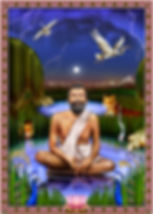1836–1886
“As many faiths, so many paths”
Rāmakṛṣṇa
Paramahaṃsa



যত মত, তত পথ



“God can be realized through all paths.
All religions are true. The important thing is to reach the roof.”
Ramakrishna Paramahansa, Gospel, 111
-
Ramakrishna Paramahansa was a Bengali saint, mystic, and religious leader, often regarded as an incarnation of God and a key figure in modern Hinduism. His life was a profound spiritual journey, embracing diverse paths—he worshipped the Goddess Kali, celebrated the devoted love of Lord Krishna, practiced Bhakti and Tantra, and explored Islamic and Christian traditions. He saw beyond religious boundaries, recognizing the ultimate unity of all paths. As the guru of Swami Vivekananda, his influence extended globally, shaping modern Hindu thought and inspiring leaders like Mahatma Gandhi, Rabindranath Tagore, and Leo Tolstoy.
-
In the painting:
In the painting, Ramakrishna is depicted at the moment of his first mystical experience. At the age of seven, he experienced his first spiritual ecstasy while walking through the rice fields. Overwhelmed by the contrast of white cranes against dark storm clouds, he collapsed into a trance. He later described this as a moment of indescribable joy and a glimpse into the divine reality beyond the material world.
In the painting, Goddess Kali’s sword appears at Ramakrishna’s side, reflecting Kali herself on the blade, making it seem as though she stands directly before him—an eternal presence in his life.
Ramakrishna was a devoted worshipper of Goddess Kali, yearning for divine visions of her. At the age of 20, after intense spiritual practice at the Dakshineswar Kali Temple, he despaired that she would not reveal herself. In a moment of surrender, as he prepared to end his life with Kali’s sword, the Divine Mother appeared before him in her radiant glory.
In The Gospel of Sri Ramakrishna, he described that profound moment:
“The buildings with their different parts, the temple, and everything else vanished from my sight, leaving no trace whatsoever, and in their stead I saw a limitless, infinite, effulgent Ocean of Consciousness. As far as the eye could see, the shining billows were madly rushing at me from all sides with a terrific noise, to swallow me up! I was panting for breath. I was caught in the rush and collapsed, unconscious. What was happening in the outside world I did not know; but within me, there was a steady flow of undiluted bliss, altogether new, and I felt the presence of the Divine Mother.”
Ramakrishna is portrayed here as a drop of water merging into a pond, creating ripples that extend far beyond its origin. He described his samadhis (mystical experiences) as merging with the "ocean of consciousness," transcending individuality—symbolising the dissolution of the ego and union with the infinite. Inspired by him, Romain Rolland introduced the concept of the "oceanic feeling," which later influenced Freud’s psychological theories.
Above him shines the moon, symbolising Ramakrishna’s mother, Chandramani, whose name means “luminous moonstone.” At the age of 45, she experienced a divine vision at a Shiva temple, where a radiant light from Shiva’s lingam entered her womb, affirming the sacred nature of her child.
The two tigers and the sheep symbolise the journey of self-realisation—before and after awakening to one's true nature. In a well-known story, a tiger raised among sheep discovers his true "tigerhood" only after being guided by a wild tiger. Through this tale, Ramakrishna illustrates how the guru’s grace shatters illusions and leads the seeker to their true essence.
The two peacocks symbolise Ramakrishna’s deep devotion to Lord Krishna and his connection to Lord Vishnu. His father, Kshudiram Chatterjee, had a vision of Vishnu in Gaya, who foretold Ramakrishna’s birth as his divine incarnation. From childhood, Ramakrishna was revered as Gopala, the child-Krishna.
At the bottom of the painting, a lotus symbolises Ramakrishna’s experience of Kundalini awakening. In a profound vision, he saw the serpent energy rise through the chakras, unfurling each lotus until the thousand-petalled lotus at the crown blossomed, marking the peak of divine consciousness.
For the full research download this PDF (coming soon)